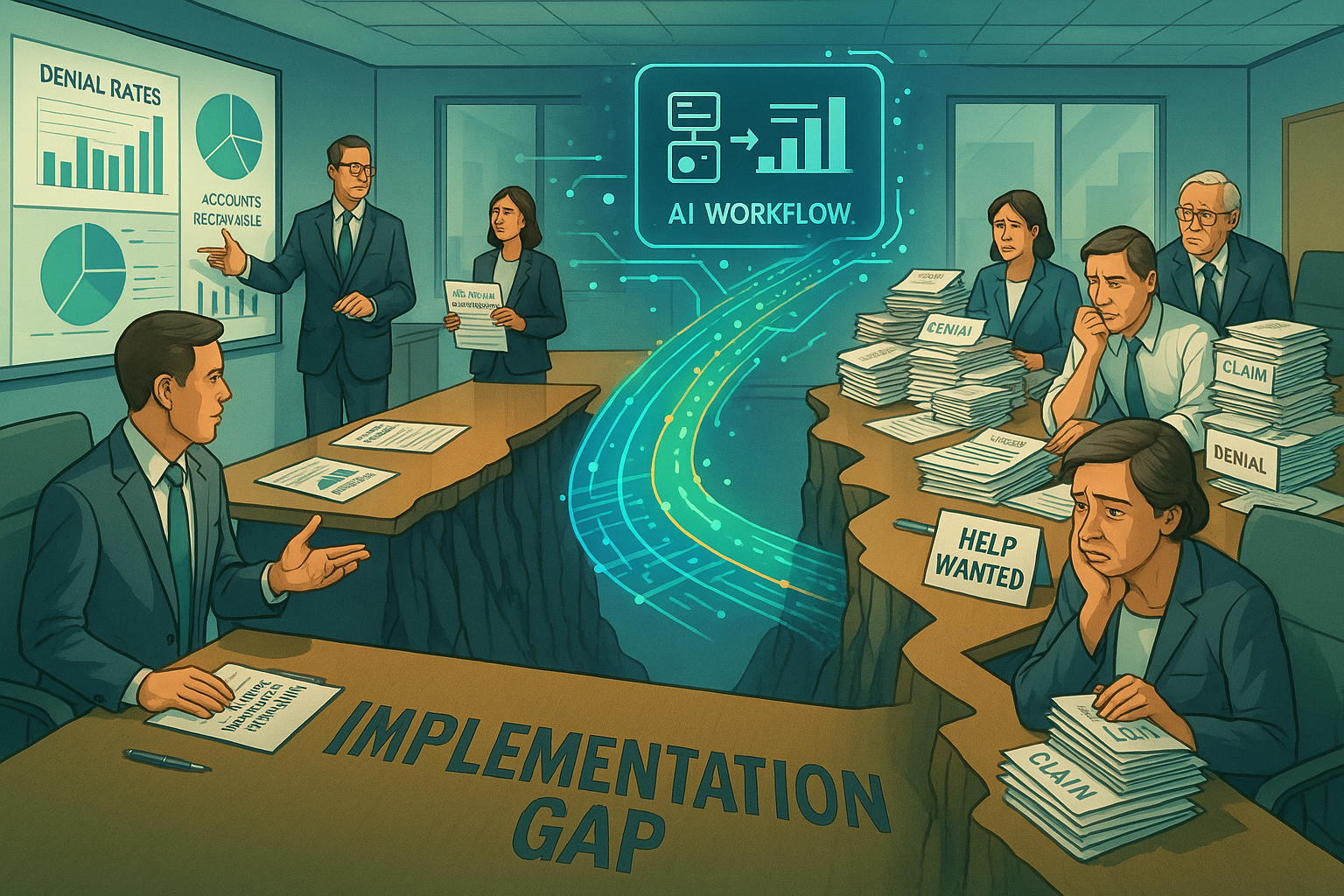In today’s complex healthcare environment, revenue cycle leaders face unprecedented challenges. Declining reimbursements, increasing claim complexity, staffing shortages, and rapidly changing payer requirements have created a perfect storm that traditional approaches simply cannot weather. For healthcare organizations and the consultants who serve them, a new paradigm is emerging—one that combines three powerful elements to transform revenue cycle performance.
Why Single-Solution Approaches Fail
Healthcare revenue cycle management has historically been plagued by siloed, incomplete solutions. Consider these common approaches and their limitations:
The Data-Only Approach
Many healthcare organizations have invested heavily in analytics platforms that provide beautiful dashboards and extensive reporting. While these tools excel at identifying problems, they suffer from a critical flaw: they generate insights without enabling action. The result? Revenue cycle teams that are increasingly aware of their problems but no better equipped to solve them.
The Automation-Only Approach
Other organizations have pursued automation as the silver bullet for revenue cycle challenges. These initiatives typically focus on streamlining specific processes like eligibility verification or claim scrubbing. While automation can drive efficiency in targeted areas, it often fails to address underlying process issues or adapt to changing conditions without continuous human oversight.
The Staffing-Only Approach
In response to persistent staffing shortages, many healthcare organizations have turned to staff augmentation services to fill critical gaps. While additional resources can temporarily alleviate backlog pressure, they rarely address the root causes of inefficiency. Without proper tools and guidance, augmented staff often perpetuate the same ineffective practices that created problems in the first place.
The reality is clear: none of these approaches alone delivers sustainable revenue cycle excellence. What’s needed is a comprehensive strategy that leverages the strengths of each while overcoming their individual limitations.
The Trifecta Approach: Creating Synergy
The most successful revenue cycle improvement initiatives combine three critical elements into a unified solution:
Element 1: Intelligent Data Analysis
Modern revenue cycle management requires analytics that go beyond descriptive reporting to deliver predictive and prescriptive insights. This means:
- Unified data sources: Merging information from EHR systems, practice management platforms, clearinghouses, and remittance files to create a comprehensive view of revenue cycle performance
- Pattern recognition: Leveraging machine learning to identify subtle trends that traditional analysis would miss
- Root cause identification: Moving beyond symptom-level metrics to uncover the underlying drivers of performance issues
- Prioritization intelligence: Focusing attention on the highest-value opportunities rather than treating all issues equally
Unlike traditional analytics, intelligent data analysis doesn’t just tell you what’s happening—it reveals why it’s happening and where to focus your efforts for maximum impact.
Element 2: Strategic Automation
Effective revenue cycle automation is far more than robotic process automation (RPA) applied to repetitive tasks. Strategic automation:
- Targets high-value processes: Focuses automation resources on activities that deliver the greatest financial return
- Adapts to changing conditions: Continuously learns and adjusts based on outcomes and evolving payer behaviors
- Integrates across systems: Bridges gaps between disparate platforms without requiring expensive system replacements
- Preserves human judgment: Automates routine decisions while escalating complex cases requiring human expertise
By implementing strategic automation, organizations can dramatically increase throughput while maintaining or improving accuracy—freeing human resources for higher-value activities.
Element 3: Specialized Staff Augmentation
The final element of the trifecta approach is thoughtfully designed staff augmentation that:
- Provides specialized expertise: Deploys resources with specific skills aligned to targeted challenges
- Scales flexibly: Expands or contracts based on volume fluctuations and project needs
- Leverages technology: Equips augmented staff with the tools and insights needed for maximum effectiveness
- Transfers knowledge: Builds internal capability rather than creating perpetual dependency
When these three elements work in concert, they create a multiplier effect that far exceeds what any single approach could achieve alone.
The Synergistic Effect: 1 + 1 + 1 = 10
The true power of the trifecta approach lies not just in combining these elements but in the synergies created between them:
- Data informs automation: Analytics identify exactly where automation will deliver the greatest ROI
- Automation enhances staff effectiveness: By handling routine tasks, automation allows both internal and augmented staff to focus on exceptions that truly require human judgment
- Staff insights improve analytics: Specialized staff provide critical context that refines analytical models
- Analytics guide staff deployment: Data-driven insights ensure augmented resources are deployed to the areas of greatest need
Consider how this plays out in the real world:
Case Study: Denial Management Transformation
A mid-sized hospital system was struggling with a 23% denial rate and a backlog of over 10,000 unworked denials. Previous attempts to address the problem through additional staffing had produced only marginal improvements while driving up costs.
By implementing the trifecta approach, the organization:
- Used intelligent analytics to identify specific denial patterns by payer, service type, and provider
- Deployed targeted automation to handle routine resubmissions and appeals for high-volume, predictable denial types
- Engaged specialized staff with payer-specific expertise to address complex denials requiring negotiation and custom appeals
The results after 90 days were dramatic:
- Denial backlog reduced by 75%
- Initial denial rate decreased from 23% to 14%
- Appeal success rate improved from 45% to 72%
- Staff productivity increased by 35%
Most importantly, these improvements were sustainable because the organization had built a system that continuously learned and adapted rather than a temporary fix.
Implementing the Trifecta Approach
For healthcare organizations and consulting firms looking to implement this approach, several key principles should guide your efforts:
Start with Comprehensive Assessment
Before implementing any solutions, conduct a thorough assessment that examines:
- Current performance metrics across the revenue cycle
- Existing technology capabilities and limitations
- Staff skill sets and capacity constraints
- Process gaps and inefficiencies
Develop an Integrated Strategy
Based on assessment findings, create a strategy that:
- Prioritizes opportunities based on financial impact and complexity
- Sequences initiatives to build momentum with early wins
- Balances short-term improvements with long-term capability building
- Addresses technology, process, and people components simultaneously
Measure and Adapt
Throughout implementation:
- Establish clear baseline metrics and improvement targets
- Measure progress frequently and transparently
- Adjust approach based on results and changing conditions
- Celebrate successes to build organizational momentum
Conclusion: The Future of Revenue Cycle Excellence
As healthcare financial pressures continue to mount, organizations can no longer afford partial solutions to revenue cycle challenges. The trifecta approach—combining intelligent analytics, strategic automation, and specialized staff augmentation—offers a comprehensive framework for achieving sustainable excellence.
For consulting firms supporting healthcare providers, this approach represents an opportunity to deliver unprecedented value. By moving beyond traditional advisory services to integrated solutions that address both diagnosis and treatment, consultants can transform their relationships with clients and drive measurable financial improvements.
The days of single-dimension solutions are over. The future belongs to organizations that skillfully integrate data, automation, and human expertise into a cohesive strategy for revenue cycle excellence.
Lockbox AI enables the trifecta approach by providing healthcare organizations and their consulting partners with an integrated platform that combines AI-powered analytics, targeted automation, and specialized staff augmentation—all focused on delivering measurable revenue cycle improvements.





